Are you tired of your usual cup of instant coffee and looking to elevate your morning routine? Look no further than the world of pour over coffee brewing techniques. With its simplicity and precision, pour over brewing offers a delightful and customizable experience that promises to awaken your taste buds. Whether you prefer a light and crisp cup or a bold and robust brew, this article will guide you through the essential techniques to create your perfect pour over coffee. From choosing the right beans to mastering the art of pouring, get ready to embark on a flavorful journey that will revolutionize your coffee-drinking experience.
Choosing the Right Equipment
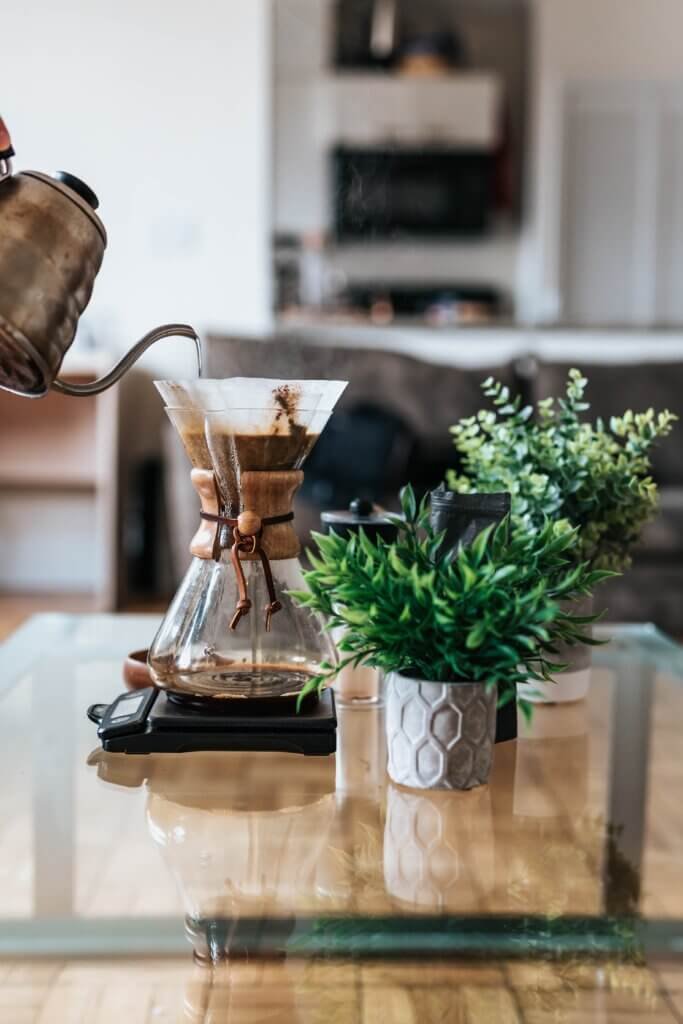
Selecting the Right Coffee Dripper
When it comes to pour over coffee brewing, selecting the right coffee dripper is essential. There are various types of coffee drippers available on the market, each with its own unique features and benefits. One popular option is the ceramic coffee dripper, known for its ability to retain heat and provide a smooth extraction. Another option is the stainless steel coffee dripper, which offers durability and resistance to corrosion. Consider your personal preferences and brewing style to choose the dripper that best suits your needs.
Choosing the Right Filter
The next step in preparing your pour over coffee is selecting the right filter. Filters play a crucial role in the brewing process as they determine the clarity and flavor of the final cup. One commonly used type of filter is the paper filter, which helps to keep the coffee grounds separate from your brewed coffee, resulting in a cleaner and brighter taste profile. Alternatively, you can opt for a metal filter, which allows more oils and silt to pass through, giving your coffee a fuller body and richer flavors. Consider your desired flavor profile and environmental preferences when choosing between paper and metal filters.
Finding the Right Coffee Beans
The quality and flavor of your pour over coffee heavily rely on the beans you choose. When selecting coffee beans, consider factors such as the roast level, origin, and flavor notes. Lighter roast coffee beans often offer a brighter and more acidic flavor profile, whereas darker roast beans provide a bolder and richer taste. Additionally, consider the origin of the beans, as different regions produce distinct flavor profiles. Take your time to explore various coffee beans, trying different origins and roast levels to find the perfect match for your pour over brewing method.
Preparing the Equipment
Rinsing the Coffee Filter
Before starting the brewing process, it is important to rinse the coffee filter. Rinsing the filter helps to remove any paper or metal residues that might affect the taste of your coffee. Simply place the filter in the coffee dripper and pour hot water through it. Discard the water and you are ready to proceed with brewing your coffee.
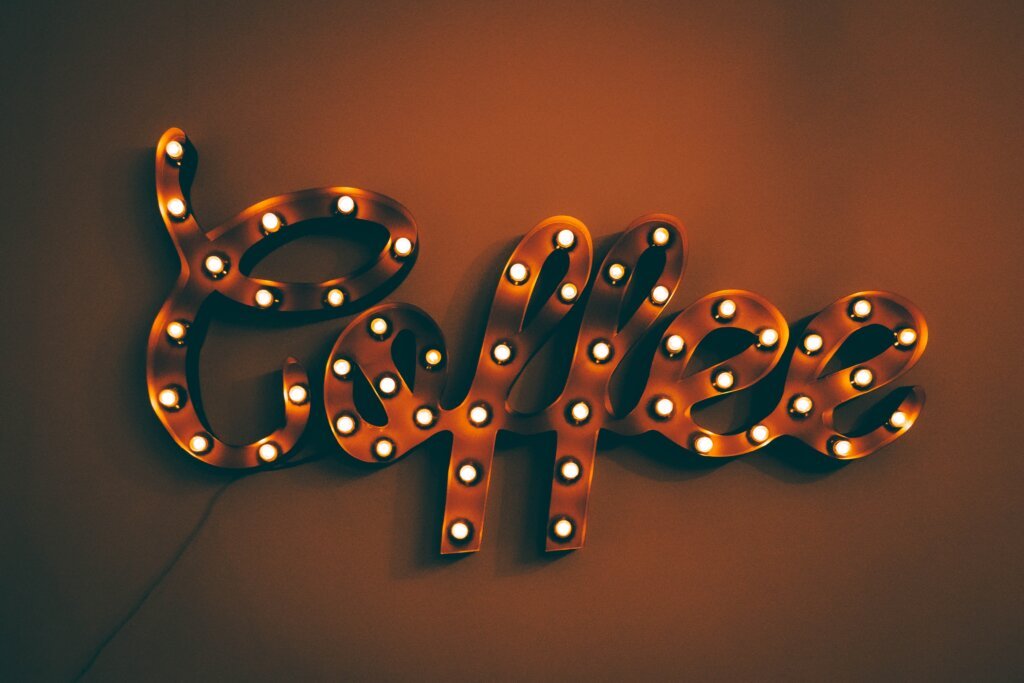
Preheating the Coffee Dripper
Preheating the coffee dripper is a crucial step that helps to ensure a consistent temperature during the brewing process. By preheating the dripper, you eliminate any heat loss that may occur when the hot water comes into contact with the cold material. To preheat the dripper, simply pour hot water into it and let it sit for a few moments before discarding the water.
Grinding the Coffee Beans
Grinding the coffee beans just before brewing ensures freshness and optimal flavor extraction. The size of the grind will depend on personal preference and the specific pour over method you are utilizing. For a pour over brewing technique, a medium to fine grind is generally recommended. The proper grind size allows for an even extraction, preventing over- or under-extraction of the coffee. Invest in a quality burr grinder to achieve a consistent grind size, enhancing the overall quality of your pour over coffee.
Measuring Ingredients
Determining Coffee-to-Water Ratio
Achieving the perfect coffee-to-water ratio is crucial for a well-balanced cup of pour over coffee. The standard ratio is generally considered to be 1:16, which means one part coffee to sixteen parts water. However, this ratio can be adjusted based on personal preference. If you prefer a stronger cup of coffee, you can increase the coffee-to-water ratio slightly. Conversely, if you prefer a milder flavor, you can decrease the ratio. Experiment with different ratios to find the perfect balance for your taste buds.
Calculating the Right Amount of Coffee
Once you have determined the desired coffee-to-water ratio, it is important to calculate the right amount of coffee. Start by determining the amount of brewed coffee you wish to make, and then use the ratio to calculate the appropriate amount of coffee grounds. For example, if you want to make 12 ounces of coffee with a 1:16 ratio, you would need 12 divided by 16, which equals 0.75 ounces of coffee. A digital scale can be a valuable tool in accurately measuring your coffee grounds.
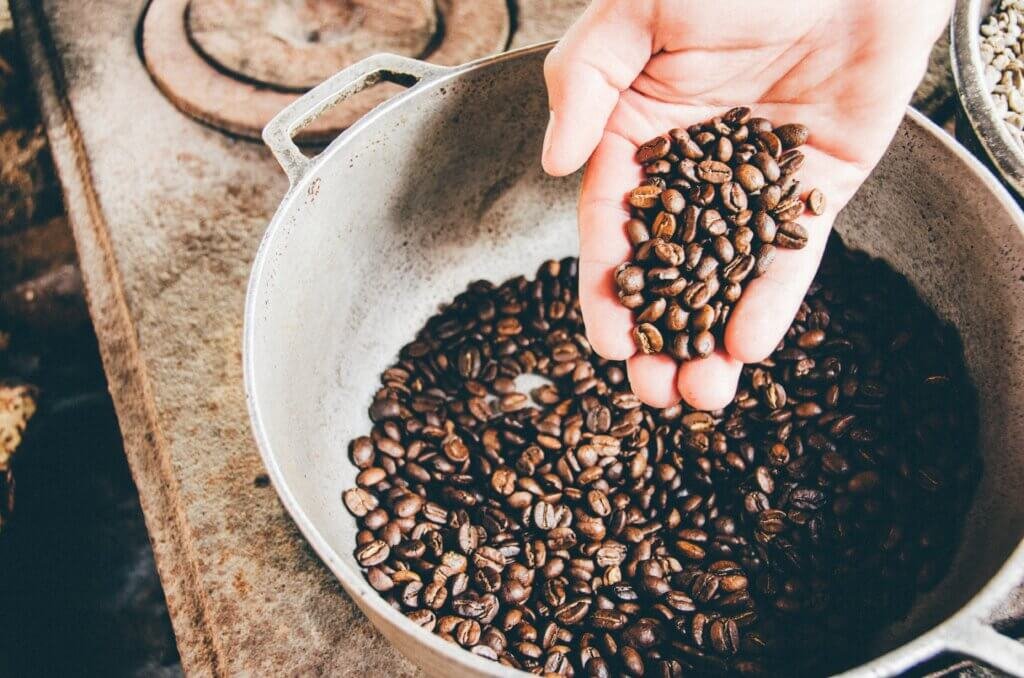
Measuring the Right Amount of Water
The final ingredient to measure is the water. It is important to measure the water accurately to ensure consistency in flavor and strength. Using a gooseneck kettle with volume markings can make this task easier. Simply pour the water slowly and carefully into the coffee dripper, ensuring that it reaches the desired level needed for your brewed coffee. Accurate water measurement is vital for achieving a well-balanced and flavorful cup of pour over coffee.
Pre-infusion
Wetting the Coffee Grounds
The pre-infusion stage involves wetting the coffee grounds before the full brew cycle begins. This allows the coffee to bloom, releasing the trapped gases and enhancing the extraction process. Start by pouring a small amount of hot water evenly over the coffee grounds, making sure all the grounds are wet. Allow the coffee to bloom for around 30 seconds before proceeding to the next step.
Allowing the Coffee to Bloom
During the blooming phase, you will notice the coffee grounds expand and release bubbles. This is a sign that the fresh coffee is degassing, and the flavors and aroma are being unlocked. Allowing the coffee to bloom ensures a more even extraction and a more flavorful cup of pour over coffee. Patience during this stage will lead to a better tasting brew.
Pouring Technique
Pouring Water in Stages
When pouring water during the brewing process, it is recommended to pour in stages rather than all at once. This technique helps to ensure an even and consistent extraction. Start by pouring a small amount of water in a circular motion, saturating all the coffee grounds. Allow the water to filter through before adding more. Continue this process, pouring in stages until you have reached the desired amount of brewed coffee.
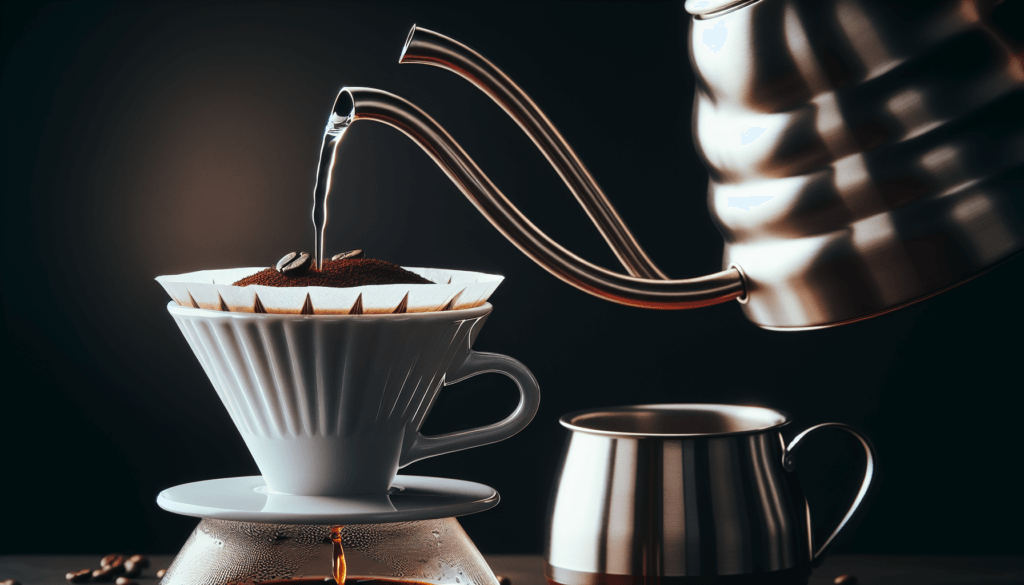
Pouring in a Circular Motion
Pouring in a circular motion helps to evenly distribute the water over the coffee grounds, promoting a balanced extraction. Begin in the center of the coffee bed and slowly spiral outward, ensuring that all the grounds are thoroughly saturated. This pouring technique helps to prevent over-extraction in certain areas and under-extraction in others, resulting in a more well-rounded cup of pour over coffee.
Maintaining Consistent Flow Rate
Consistency in the flow rate of your pour-over is essential for a balanced extraction. Pouring too quickly can lead to over-extraction, while pouring too slowly can result in under-extraction. Aim for a steady and controlled pour throughout the brewing process, maintaining an even flow rate. Practicing your pouring technique and adjusting the speed as needed will help achieve a consistent and delicious cup of pour over coffee.
Avoiding Overflowing
Pouring technique plays a crucial role in avoiding overflowing during the brewing process. Pouring too much water at once can cause the coffee to overflow and create a mess. To prevent this, pour the water slowly and steadily, allowing it to filter through before adding more. Be mindful of the coffee dripper’s capacity and adjust your pouring technique accordingly to maintain control and avoid any mishaps.
Brew Time and Temperature
Determining Ideal Brew Time
The ideal brew time for pour over coffee will vary depending on factors such as grind size, desired strength, and personal preference. As a general guideline, aim for a brew time of around 3 to 4 minutes. However, experimenting with shorter or longer brew times can allow you to fine-tune your coffee’s flavors. Keep track of the brew time and adjust as needed until you find the perfect balance that suits your taste buds.
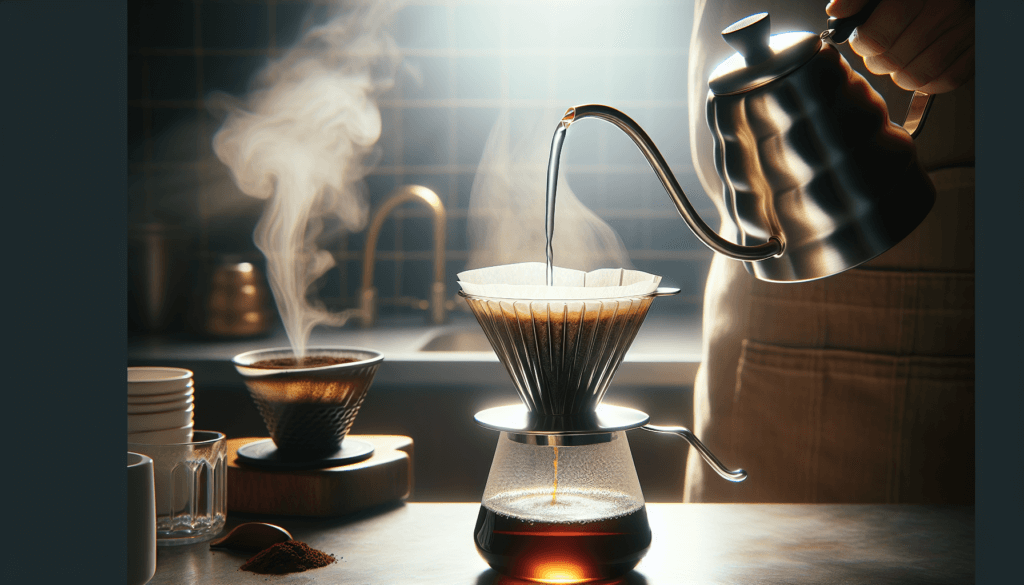
Maintaining Proper Water Temperature
Water temperature is a crucial factor in achieving optimal coffee extraction. The recommended water temperature for pour over brewing is between 195 to 205 degrees Fahrenheit (90 to 96 degrees Celsius). Maintain the water temperature within this range throughout the entire brewing process to ensure proper extraction and to achieve the best flavor and aroma from your coffee.
Managing Heat Loss
Heat loss can occur during the brewing process and result in a lower water temperature, leading to under-extraction. To minimize heat loss, it is recommended to preheat your equipment, as mentioned earlier. Additionally, using a thermal coffee dripper or a well-insulated brewing setup can help retain heat. If you find that your brews consistently lack heat, you may need to adjust your pouring technique to pour at a slightly slower pace or even invest in a temperature-controlled kettle to ensure consistent water temperature.
Troubleshooting
Adjusting Grind Size
If you find that your pour over coffee tastes weak or lacks complexity, it could be an indication that the grind size needs adjustment. In general, a finer grind size will result in a stronger and more flavorful cup of coffee, while a coarser grind size will produce a milder flavor. Experiment with different grind sizes until you achieve the desired taste profile. Remember to keep track of your adjustments to maintain consistency in future brews.
Modifying Pouring Technique
Poor extraction or uneven flavors can be signs that your pouring technique needs modification. Be mindful of your pour rate, circular motion, and water distribution. If you notice some areas of the coffee bed are consistently over-extracted or under-extracted, adjust your pouring technique accordingly. Practice and experimentation will help refine your pouring skills and result in a more consistent and flavorful cup of pour over coffee.
Making Temperature Adjustments
If your coffee tastes overly bitter or lacks depth, it may indicate that the water temperature needs adjustment. If the coffee is too bitter, the water may be too hot, resulting in over-extraction. Lowering the water temperature slightly can help achieve a better balance. On the other hand, if the coffee tastes weak or lacks complexity, the water may not be hot enough. Adjusting the water temperature within the recommended range can help fine-tune the flavors of your pour over coffee.
Cleaning and Maintenance
Disposing of the Coffee Grounds
After enjoying a delicious cup of pour over coffee, it is important to properly dispose of the coffee grounds. Never dispose of the grounds down the sink, as they can clog the drain over time. Coffee grounds can be added to compost or used as a natural fertilizer for plants. If you don’t have access to a compost or garden, simply discard the grounds in the trash.
Cleaning the Coffee Dripper
To keep your coffee dripper in optimal condition, regular cleaning is essential. After each use, rinse the dripper thoroughly with warm water to remove any residue. If necessary, use a small brush to scrub away any stubborn coffee stains. Periodically give the dripper a deep clean by soaking it in a mixture of warm water and mild dish soap. Rinse thoroughly and allow it to air dry before storing.
Taking Care of Your Equipment
Proper care of your pour over coffee equipment ensures longevity and consistent performance. It is important to handle ceramic or glass coffee drippers with care as they can be fragile. Avoid exposing them to extreme temperature changes, which can cause cracking. Stainless steel drippers should be wiped clean after each use to prevent corrosion. Store your equipment in a clean and dry place, protecting it from any potential damage.
Experimenting with Variations
Trying Different Coffee Beans
One of the joys of pour over coffee brewing is the ability to experiment with various coffee beans. Explore different origins, roast levels, and flavor profiles to discover new and exciting taste experiences. Single-origin beans can showcase the unique characteristics of a specific region, while blends offer a harmonious balance of flavors. Take the opportunity to try new beans and expand your coffee palate.
Exploring Various Brew Ratios
While the standard coffee-to-water ratio is a good starting point, don’t be afraid to explore different brew ratios to suit your preferences. Adjusting the amount of coffee or water can significantly alter the flavor and strength of your brew. Experiment with ratios such as 1:15 or 1:17 to find your perfect balance. Keep in mind that each variation may require adjustments in grind size and brewing time.
Testing Temperature and Brew Time Variations
Temperature and brew time are two variables that greatly influence the taste of your pour over coffee. Experimenting with temperature variations, such as slightly increasing or decreasing the water temperature, can result in different flavor profiles. Similarly, adjusting the brew time by a few seconds can bring out different taste characteristics. Keep track of your experiments, taking note of the variations that yield the most desirable results.
Comparison with Other Brewing Methods
Exploring Differences with French Press
Pour over brewing and French press brewing are two popular manual brewing methods, each offering unique characteristics. While pour over coffee tends to have a lighter body and cleaner taste, French press coffee is known for its fuller body and rich flavors. The pour over method allows for more control over the extraction process and results in a more nuanced cup of coffee. French press brewing, on the other hand, extracts oils and sediments, resulting in a bolder cup. Consider your personal preferences and desired flavor profile when choosing between the two methods.
Contrasting with Automatic Drip Coffee
Automatic drip coffee makers are a convenient option for brewing large quantities of coffee. However, they lack the precision and control offered by pour over brewing. Pour over coffee allows for a more hands-on approach, giving you the ability to adjust variables such as water temperature, pour rate, and brew time. This level of control results in a more customizable cup of coffee tailored to your preferences. If you value the art and craft of coffee brewing, pour over is a great alternative to automatic drip machines.
Comparing Pour Over with Espresso
Espresso is a concentrated coffee brewing method that utilizes high pressure and finely ground coffee to extract intense flavors quickly. Pour over coffee, on the other hand, is a slower and more deliberate process that emphasizes clarity and balance. While espresso offers a concentrated and robust flavor experience, pour over coffee provides a more nuanced and delicate flavor profile. Each method has its own unique qualities and purpose, allowing coffee lovers to choose based on their preferences and desired coffee experience.
In conclusion, mastering the art of pour over coffee brewing requires attention to detail, patience, and experimentation. From choosing the right equipment to perfecting your pouring technique, every step plays a crucial role in achieving a delicious cup of coffee. Remember to approach the process with a sense of curiosity and enjoyment, as the journey of exploring different beans, ratios, and techniques is part of the beauty of pour over coffee brewing. With practice and a bit of creativity, you can elevate your coffee brewing skills and indulge in the rich flavors and aromas of a perfectly brewed pour over cup of coffee.


